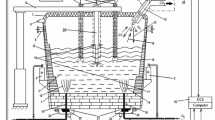Abstract
The use of cast iron in the metallic charge of electric melting allows: the creation of a carbon content reserve, in which heat and mass transfer processes are intensified during oxidation and slag foaming is carried out; the reduction of non-ferrous metal impurity (Cr, Ni and Cu) content in the metallic charge; the acquisition of an additional heat source (when using molten cast iron); and the increase of scrap melted faster, even with a minor portion of molten cast iron freezing onto scrap pieces heaped into the furnace which can lower the melting point of the metal. Cast iron in the metallic charge of modern electric arc furnaces (EAF), depending on the structure of the metallurgical enterprise, can be used in mini-plants in the solid form and in enterprises of a full production cycle—both in solid and liquid form. The solid cast iron proportion in the charge of electric melting usually does not exceed 10%, but if necessary, it can increase up to 30% if the special technique of loading the charge into the furnace is observed. Liquid cast iron consumption can reach 50–70%. It is possible to conduct an electric steelmaking process in conjunction with an oxygen-converter in a twin-shell Conarc unit. A variant of such a unit is considered when applied to the ESPTs PAO MMK when using 50% liquid cast iron in a charge with predicted technological parameters.


Similar content being viewed by others
REFERENCES
Grigorovich, K.V., The current state of ferrous metallurgy and its development in the digital economy, Trudy XV Mezhdunarodnogo kongressa staleplavil’shchikov i proizvoditelei metalla (Proc. XV Int. Congr. of Steelmakers and Metal Manufacturers), Moscow: Assots. Staleplavil’shchikov, 2018, pp. 42–59.
Roshchin, V.E. and Roshchin, A.V., Elektrometallurgiya i metallurgiya stali (Electrometallurgy and Metallurgy of Steel), Chelyabinsk: Yuzhn.-Ural. Gos. Univ., 2013.
Bigeev, V.A., Stolyarov, A.M., and Valiakhmetov, A.Kh., Metallurgicheskie tekhnologii v vysokoproizvoditel’nom elektrostaleplavil’nom tsekhe: uchebnoe posobie (Metallurgical Technologies in High-Tech Electric Smelting Shop: Manual), Magnitogorsk: Magnitogorsk. Gos. Tekh. im. G.I. Nosova, 2014.
Bigeev, V.A., Valiakhmetov, A.Kh., Burak, I., and Fedyanin, A.N., Smelting of steel in a super powerful arc furnace with higher consumption of solid cast iron, Vestn. Magnitogorsk. Gos. Tekh. im. G.I. Nosova, 2014, no. 1, pp. 15–19.
Alekseev, L.V. and Stolyarov, A.M., Specific smelting of the semiproduct in super powerful arc steelmaking furnace with different consumption of liquid cast iron, Vestn. Magnitogorsk. Gos. Tekh. im. G.I. Nosova, 2008, no. 4 (24), pp. 69–72.
Alekseev, L.V. and Stolyarov, A.M., Analysis of the main performance indicators of super-powerful steelmaking arc furnace with different consumption of liquid cast iron, Stal’, 2009, no. 3, p. 85.
Kudrin, V.A., Teoriya i tekhnologiya proizvodstva stali (The Theory and Technology of Steelmaking), Moscow: AST, 2003.
Bigeev, V.A., Kolesnikov, Yu.A., Fedyanin, A.N., et al., The convergence of steelmaking technology in an oxygen converter and an electric arc furnace, Teor. Tekhnol. Metall. Proizvod., 2015, no. 2 (17), pp. 35–38.
Author information
Authors and Affiliations
Corresponding author
Additional information
Translated by S. Avodkova
About this article
Cite this article
Bigeev, V.A., Stolyarov, A.M. & Potapova, M.V. Using Cast Iron for Steel Melting in an Electric Arc Furnace. Steel Transl. 49, 695–697 (2019). https://doi.org/10.3103/S0967091219100048
Received:
Published:
Issue Date:
DOI: https://doi.org/10.3103/S0967091219100048



